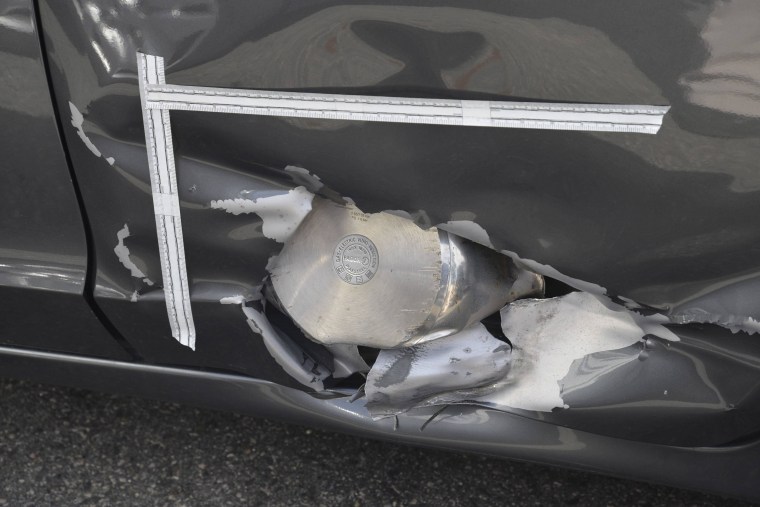BOSTON — One of the biggest mysteries in the Boston Marathon bombing case — where the bombs were made — remains unsolved, the FBI says.
FBI explosives analyst David McCollam told the jury in the Dzhokhar Tsarnaev death penalty trial Thursday that he could not determine where the bombs were assembled. However, McCollam did say that explosive residue consistent with the Boston Marathon bombs was found at the Tsarnaev family apartment in Cambridge and in a Honda CRV driven by Tsarnaev's older brother, Tamerlan, who was killed in a shootout with police four days after the attack.
McCollum described how agents used vacuums to collect tiny fragments of debris from the apartment. “Some of the (vacuum) filters did indicate some residue of pyrotechnics,” McCollam said during the trial's fourteenth day of testimony.
Four samples from the apartment contained grains of black powder, McCollam said.
Residue was also found on the fingertips of latex gloves in the car, McCollam said. “There was some black smudging in the fingerprint area,” he said.
Three people were killed and more than 260 people injured when two bombs exploded near the finish line of the marathon on April 15, 2013. There were 17 amputations the day of the explosions. Dzhokhar Tsarnaev faces the death penalty if convicted on any of 17 counts of a 30-count indictment.
McCollam’s team analyzed about 300 pieces of evidence at the FBI lab in Quantico, Virginia, beginning the day after the bombing. He said residue from two bombs found near the finish line of the marathon on Boylston Street was consistent with fireworks, as was the evidence taken from Cambridge. Agents at the bombing sites found large metal fragments with black residue that they scraped off to test, he said.
Agents have testified they found nails, BBs, wire, a battery charger, a fuse and parts of pressure cookers at the apartment that they considered possible ingredients of a homemade bomb like those used at the marathon. Fireworks were also found in Dzhokhar Tsarnaev’s dorm room at University of Massachusetts Dartmouth, tested at the FBI lab and presented as evidence. Some of the evidence at the Cambridge apartment was vacuumed and bagged before being entered as evidence.
FBI Supervisory Agent Edward Knapp, following McCollam, said the marathon bombs were set off by model car controllers. Earlier this week, the government presented receipts for a model truck, a remote control and items associated with radio control cars allegedly purchased by Tamerlan Tsarnaev. He allegedly commented on the website selling the devices: “You have a good website but a lot of your stuff is out of stock. It’s a little bit sad … ”
There was fragmentation or shrapnel found at both bomb sites, Knapp testified. “You typically see this on anti-personnel devices.”
He said that after the bombing, “There was stuff coming from the medical examiner’s office, Scene A, Scene B [the two Boylston Street bomb sites].”

Knapp said a Christmas tree light bulb — like the ones found at the Tsarnaev family apartment — has enough power to set off a low explosive charge. He testified that the “initiator” in the bomb at the finish line was a green Christmas tree light bulb strand.
He described the “remnants of an electronic speed controller” from a model car found at the scene as “just basically a switch in the fusing system, the small leads there hook up to the receiver, the larger lead goes to the battery.”
Knapp said a hobby fuse was found at both bomb sites. If the remote control devices failed, he said, “all you’d have to do is light the hobby fuse and walk away.”
The Tsarnaev brothers purchased all the components found at both scenes and were able to reproduce the bombs, Knapp said. He said there were BBs found at both scenes along with small nails at the second scene.
As the government displayed all the charred fragments of the pressure cookers recovered from both scenes — along with blood-soaked towels and clothing — Knapp said a pressure cooker piece was “stamped” in the shape of a grate it landed on.
He said the FBI created “mockups” of bombs at the marathon and Watertown gun battle site, using the same components including Christmas lights and pieces of a Monster Rally RC truck.
Asked how sophisticated one would have to be create such improvised explosive devices, Knapp said, “It’s not that … sophisticated.”
Directed by Assistant U.S. Attorney Aloke Chakravarty, Knapp read through the instructions from Inspire magazine’s “How To Make A Bomb In The Kitchen Of Your Mom.” One section said, “the pressurized cooker is the most effective method.”
Tsarnaev’s lawyers have admitted that he and his older brother, Tamerlan, planted and detonated the bombs. But they say Tamerlan Tsarnaev was the mastermind of the attack.
Knapp showed the jury a mock version of a pressure cooker bomb like those used at the marathon. He put it in a backpack and gave it to jurors to hold. They seemed surprised at how heavy it was.
The day's testimony ended with jurors seeing graphic autopsy photos of Krystle Campbell, one of the three people who died in the blasts, and a medical examiner's description of her wounds, which included shrapnel. The doctor, Jennifer Hammers, said Campbell likely bled to death soon after the explosions.
Prosecutor William Weinreb asked Hammers how long she thought Campbell lived with her injuries.
Hammers responded, "From seconds until possibly a minute."